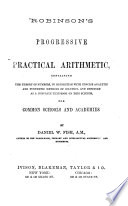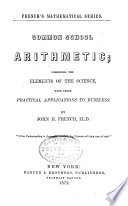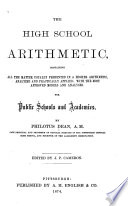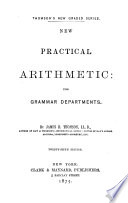 | Henry Bartlett Maglathlin - Arithmetic - 1869 - 332 pages
...the difference of the extremes by the number of terms less one. Also, to find the number of terms, Divide the difference of the extremes by the common difference, and add one to the quotient. Exercises. 1. The extremes of an arithmetical series are 5 and 27^, and the number... | |
 | Robert Stewart (of Dundee.) - Arithmetic - 1871 - 248 pages
...their ages? CASE III. When the extremes and common difference are given, to find the number of terms. RULE.— Divide the difference of the extremes by the common difference, and add 1 to the quotient for the number of terms. 8. If the extremes of an arithmetical series be 4 and 24, and the common difference... | |
 | Horatio Nelson Robinson, Daniel W. Fish - Arithmetic - 1858 - 378 pages
...term, we have left the common Difference taken as many times as the number of terms, less 1, Hence, RULE. Divide the difference of the extremes by the common difference, and add I to the quotient. EXAMPLES. 1. The extremes are 7 and 43, and the common difference is 4 ; what is... | |
 | Benjamin Greenleaf - Arithmetic - 1871 - 350 pages
...the number of differences ; therefore 9 -)- 1 = 10 is the number of terms in this series. Hence the RULE. — Divide the difference of the extremes by the common difference, and the quotient, increased by 1, will be the number, of terms. EXAMPLES FOR PRACTICE. 1. If the extremes... | |
 | John Homer French - Arithmetic - 1872 - 344 pages
...difference of the extremes by the number of terms less 1. HE. To find the number of terms. Divide Ike difference of the extremes by the common difference, and add 1 to the quotient. IV. To find the sum of the series. Multiply one half the sum of the extremes by the number of terms.... | |
 | Joseph Ray - 1856 - 400 pages
...39. Ant. 3j ART. 413. To find the number of terms, when the extremes and common difference are known. RULE. — Divide the difference of the extremes by the common difference, and add 1 to the quotient. 1. What is the number of terms in a series whose extremes are QL and 42, and common difference, 3?... | |
 | Henry Bartlett Maglathlin - Arithmetic - 1873 - 362 pages
...the difference of the extremes by the number of terms less one. Also, to find the number of terms, Divide the difference of the extremes by the common difference, and add one to the quotient. Exercises • 1. The extremes of an arithmetical series are 5 and 27£, and the... | |
 | Philotus Dean - Arithmetic - 1874 - 472 pages
...— 1) d, it is plain that (I — a) ч- = n — 1, and that ((I — a) ч- d) + 1 — n. Hence the Rule. — Divide the difference of the extremes by...the quotient. EXAMPLES FOR PRACTICE. 1. The extremes are 2 and 30, and the common difference f ; what is the number of terms? Ans. 36. 2. The annual interest... | |
 | James Bates Thomson - 1875 - 392 pages
...must be the number of terras less i ; and II + 1, or I2,is the answer required. (Art. 93.) Hence, the RULE. — Divide the difference of the extremes by the common difference, and add i to the quotient. 7. The youngest child of a family is i year, the oldest 21, and the common difference... | |
 | James Bates Thomson - 1876 - 400 pages
...number of terms less I; and 11 +1,or I2,is the answer required. (Art. 93.) Hence, the RULE.—Divide the difference of the extremes by the common difference, and add 1 to the quotient. 7. The youngest child of a family is 1 year, the oldest 21, and the common difference of their ages... | |
| |